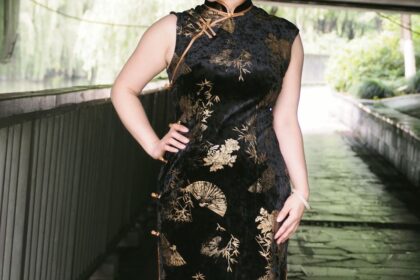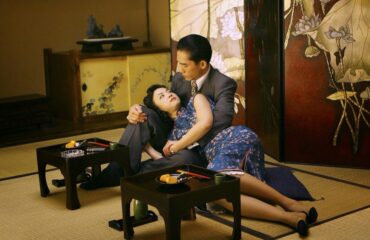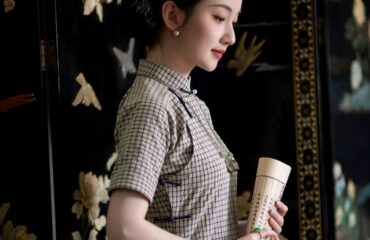
The Cheongsam, or Qipao, stands as one of the most iconic and recognizable garments in the world. With its elegant, form-fitting silhouette, distinctive mandarin collar, and intricate details, it is a powerful symbol of Chinese culture, femininity, and timeless style. More than just a piece of clothing, the Cheongsam is a story woven in silk and thread—a narrative of historical transformation, artistic expression, and enduring grace. Its journey from the stately robes of the Qing Dynasty to the glamorous stages of international cinema and modern fashion runways reflects the dynamic evolution of China itself. This dress, celebrated for its ability to exude both modesty and allure, continues to captivate hearts and minds, proving that true elegance never fades.
1. A Journey Through Time: The Origins and Evolution of the Cheongsam
Contrary to popular belief, the Cheongsam is not an ancient garment with thousands of years of history. Its origins are more recent, tracing back to the 17th-century Qing Dynasty, established by the Manchu people. Manchu women wore a one-piece, loosely fitted robe called the changpao (長袍), which was designed for practicality, especially for horseback riding. This early version was A-line in shape, had long sleeves, and covered most of the body, bearing little resemblance to the figure-hugging dress known today.
The true birth of the modern Cheongsam occurred in the cosmopolitan hub of 1920s Shanghai. As China opened up to Western influences, society underwent a seismic shift. Women, newly empowered and educated, sought a style that reflected their modern identity. They began adapting the traditional changpao, incorporating Western tailoring techniques to create a more streamlined and flattering silhouette. The garment became slimmer, the hemlines rose, and variations in sleeves and collars appeared.
The 1930s and 1940s are often considered the “Golden Age” of the Cheongsam. It became the definitive dress for urban Chinese women, from socialites and movie stars to everyday citizens. Designers experimented with high-necked, sleeveless styles, daring side slits, and a variety of luxurious fabrics. After the founding of the People’s Republic of China in 1949, the Cheongsam’s popularity waned on the mainland due to its association with bourgeois culture. However, it flourished in Hong Kong, Taiwan, and among overseas Chinese communities, where it was preserved and continued to evolve, solidifying its status as a quintessential symbol of Chinese heritage.
| Era | Key Characteristics | Cultural Context |
|---|---|---|
| Qing Dynasty (17th-20th C) | Loose, A-line changpao; wide cut; long sleeves. | Manchu administrative attire, designed for practicality. |
| 1920s Shanghai | Slimmer silhouette emerges; hemlines rise; introduction of Western tailoring. | Rise of the “New Woman”; blending of Eastern and Western cultures. |
| 1930s-1940s (Golden Age) | Body-hugging fit; high collars; sleeveless designs; high side slits. | Symbol of modernity, glamour, and sophistication. |
| 1950s-1970s | Decline in mainland China; preserved and popularized in Hong Kong and Taiwan. | Became an iconic element in Hong Kong cinema and formal wear. |
| 1980s-Present | Global revival; interpretation by international designers; modern variations. | Re-embraced as a cultural symbol and versatile fashion piece. |
2. The Anatomy of a Cheongsam: Key Design Elements
The unique charm of the Cheongsam lies in its distinct structural components, each contributing to its overall elegance and form. Understanding these elements reveals the thoughtful craftsmanship behind the dress.
- The Mandarin Collar (立領 / lìlǐng): The stiff, standing collar is perhaps the most defining feature. It can vary in height, from a low, subtle band to a dramatic high collar that frames the neck gracefully. This feature lends an air of dignity and poise to the wearer.
- The Closure (襟 / jīn): Traditionally, the Cheongsam features a diagonal opening known as the dajin, which fastens on the right side of the body. This asymmetrical closure is both functional and decorative, creating a beautiful line that sweeps across the chest.
- The Pankou (盤扣 / pánkòu): These are the intricate, hand-knotted buttons that secure the closure. Made from fabric strips, often of the same material as the dress or a contrasting color, pankou are miniature works of art. They come in various shapes, from simple straight knots to elaborate floral or butterfly designs, adding a touch of exquisite detail.
- The Sleeves (袖 / xiù): Cheongsam sleeves have seen numerous variations over the decades. They can range from long and bell-shaped in early versions to short, capped, or flutter sleeves. The sleeveless style, which gained popularity in the mid-20th century, is particularly favored for its sleek, modern look, especially in warmer climates.
- The Side Slits (衩 / chà): The side slits are a crucial element that balances modesty with allure. They allow for freedom of movement in the otherwise restrictive, narrow skirt. The height of the slits can vary dramatically, from a modest opening at the knee to a daring “thigh-high” cut, allowing the wearer to choose a level of sensuality that suits the occasion and personal comfort.
| Feature | Description | Common Variations |
|---|---|---|
| Collar | Stiff, standing collar framing the neck. | Low, medium, or high collar styles. |
| Closure | Asymmetrical opening, typically fastening on the right. | Right-sided diagonal (dajin), center, or back zipper on modern versions. |
| Pankou | Hand-knotted fabric buttons. | Simple straight knots (“one-line”), complex floral, or animal shapes. |
| Sleeves | Arm coverings. | Sleeveless, capped, short, elbow-length, long. |
| Slits | Openings on one or both sides of the skirt. | Low (below knee), medium (at knee), high (above knee). |
3. Fabric and Symbolism: Weaving Stories into Cloth
The choice of fabric and decorative motifs is fundamental to the Cheongsam’s identity, transforming it from a simple garment into a canvas for storytelling and cultural expression.
Traditionally, Cheongsams were crafted from luxurious materials that signified status and wealth. Silk, with its luminous sheen and smooth drape, was the most coveted fabric. Brocade, a rich, shuttle-woven fabric with raised patterns, often featuring metallic threads, was used for formal and ceremonial wear. Velvet offered a plush, opulent texture perfect for winter, while fine linen and cotton were used for more casual, everyday versions. Today, modern Cheongsams incorporate a wider array of materials, including rayon, polyester blends, and stretch fabrics, which offer greater comfort, durability, and affordability.
The patterns and motifs embroidered or woven into the fabric are imbued with deep symbolic meaning rooted in Chinese folklore and philosophy.
- Dragon (龍 / lóng) and Phoenix (鳳 / fèng): This is the ultimate pairing, representing the emperor and empress, respectively. Together, they symbolize perfect marital bliss and supreme good fortune.
- Peony (牡丹 / mǔdān): Known as the “king of flowers,” the peony is a symbol of wealth, prosperity, beauty, and honor.
- Lotus (蓮花 / liánhuā): Rising clean from muddy waters, the lotus represents purity, enlightenment, and integrity.
- Fish (魚 / yú): The word for fish is a homophone for the word for abundance or surplus. A pair of fish symbolizes harmony and conjugal bliss.
- Bamboo (竹 / zhú): Valued for its strength and flexibility, bamboo represents resilience, integrity, and longevity.
Colors also play a vital role. Red is the color of luck, joy, and celebration, making it the overwhelming choice for weddings and Lunar New Year festivities. Gold and yellow have imperial connotations, signifying wealth and royalty. Green is associated with youth and health, while blue symbolizes tranquility and elegance.
4. The Cheongsam in the Modern World: From Tradition to Trend
Once confined to cultural enclaves, the Cheongsam has re-emerged on the global stage as a powerful and versatile fashion statement. Its influence is visible in the collections of top international designers, who have repeatedly drawn inspiration from its unique collar, closure, and silhouette.
Film has been instrumental in cementing the Cheongsam’s iconic status. Director Wong Kar-wai’s masterpiece In the Mood for Love (2000) is a visual love letter to the dress, with actress Maggie Cheung wearing over twenty different stunning Cheongsams that perfectly capture the repressed passion and languid elegance of 1960s Hong Kong. These cinematic portrayals have introduced the garment’s beauty to a new generation worldwide.
Contemporary designers and brands are continuously re-imagining the Cheongsam to suit modern lifestyles. Specialized platforms like Cheongsamology.com showcase this evolution, featuring designs that blend traditional craftsmanship with contemporary aesthetics. Innovations include using unconventional fabrics like denim or jersey, incorporating modern digital prints, altering the cut for a more relaxed fit, creating two-piece sets with a crop top and skirt, or adding practical elements like pockets. This adaptability ensures that the Cheongsam is not merely a costume for special occasions but can be integrated into a modern wardrobe, worn to the office, a brunch, or a formal event with equal aplomb.
5. Choosing and Wearing a Cheongsam with Grace
Wearing a Cheongsam is an experience in poise and elegance. To ensure the dress is shown to its best advantage, a few considerations are key.
First and foremost, fit is paramount. A well-made Cheongsam should skim the body’s curves without being constricting. It should be snug at the bust, waist, and hips, but allow for comfortable movement. Off-the-rack options are widely available, but for a truly perfect fit, a bespoke, tailor-made Cheongsam is an unparalleled investment.
The style should be chosen to flatter one’s body type and suit the occasion. A higher collar can elongate the neck, while a lower one may be more comfortable for those with shorter necks. The height of the side slits should be considered; lower slits are more conservative and formal, while higher slits are bolder and better suited for evening events.
Accessorizing should be done with intention. Classic pairings include elegant high heels, a simple clutch bag, and delicate jewelry such as pearl earrings or a jade bracelet. An updo or a chic chignon is a traditional hairstyle that beautifully showcases the mandarin collar and the line of the neck. When individuals from other cultures choose to wear a Cheongsam, it is important to do so with an appreciation for its rich history and significance, embracing it as a beautiful form of cultural exchange rather than a mere costume.
The Cheongsam is far more than just a dress. It is a cultural artifact, a masterpiece of design, and a testament to the resilience and adaptability of tradition. From its noble origins as a Manchu robe to its dazzling transformation in Shanghai and its current status as a global fashion icon, the Cheongsam has consistently captured a unique spirit of feminine strength and grace. It embodies a delicate balance—between concealment and revelation, tradition and modernity, simplicity and intricacy. Its enduring charm lies in its ability to tell a story of cultural pride while empowering the wearer with an unmatched sense of elegance and confidence, securing its place in the history of fashion forever.


